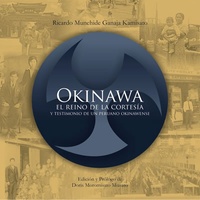Argentina y Brasil, los dos colosos de América del Sur, celebran este año el primer centenario de la inmigración okinawense. En sus programas figuran conciertos, foros, torneos deportivos y eisa o marchas artísticas. Coincidentemente, en el Perú se acaba de publicar el libro Okinawa: el reino de la cortesía y testimonio de un peruano okinawense de Ricardo Munehide Ganaja Kamisato, que brinda luces sobre un tema común para la mayoría de comunidades nikkei okinawenses: el tema de la búsqueda de una identidad japonesa-okinawense y, en este caso, peruana.
Inmigración okinawense en América
Fue la insoportable pobreza y las cada vez peores condiciones económicas impuestas por el expansivo Estado japonés que empujaron a miles de okinawenses a emigrar al extranjero. El pago obligado de los altos impuestos ya no permitía sobrevivir en la naturaleza agreste de las 160 islas que componen la prefectura de Okinawa. Así, sus habitantes eligieron libremente diversos destinos, entre los cuales estaba el continente americano. Kyuzo Toyama, llamado el “Padre de los emigrantes okinawenses” y funcionario de compañías de emigración, fue el principal organizador de la salida de sus coterráneos al extranjero.
Los destinos más codiciados fueron Estados Unidos, Canadá y Hawai. En 1904 un grupo arribó a Filipinas para trabajar en las plantaciones, y otro grupo desembarcó en México para trabajar en las minas y empresas ferrocarrileras. En 1906 el destino fue Perú, en donde trabajaron en las haciendas de caña de azúcar. Según relata Lesley Chinen1, en Cuba la migración de okinawenses se inició en 1907. Ese mismo, año un grupo de trabajadores arribó a Canadá. En 1908, el destino fue Brasil para trabajar en las plantaciones de café. Después seguirían Argentina, Colombia, Bolivia, Paraguay, entre otros territorios latinoamericanos.
Testimonio de un nikkei peruano okinawense
Muchos libros se han escrito sobre la inmigración japonesa al Perú, pero el libro Okinawa: el reino de la cortesía y testimonio de un peruano okinawense tiene el valor que tienen los testimonios: el de la autoconstrucción de sí mismo a través del relato. En él su autor, Ricardo Munehide Ganaja Kamisato, cuenta del proceso de la construcción de una comunidad de inmigrantes a través de la experiencia de un individuo, desde sus intimidades, espacios privados, la cotidianeidad, las vivencias y sus expectativas como ciudadano peruano. De hecho, es la historia de un grupo humano narrada desde su interior e impregnada de alegrías, rabia, confusión, y muchísimo humor.
Lo valioso de este libro es la sinceridad de su autor al describir la construcción de su identidad a partir de la autoexclusión y de la conciencia de marginación en la comunidad nikkei; es decir, relata los conflictos internos entre descendientes japoneses y okinawenses, muestra cómo estas diferencias se convierten en discriminaciones y jerarquías que dominan los pensamientos, los discursos y las relaciones entre sus miembros. A este conflicto interno se agregan los prejuicios y desprecios raciales contra los habitantes peruanos, sobre todo de territorios andinos llamados serranos. No es raro, entonces, que Ganaja en un pasaje del libro se pregunte si, por ser de origen okinawense, él es ¿un prestigioso japonés o un devaluado serrano okinawense?
Lo más rescatable de sus textos es que, en la medida en que va narrando su vida, Ganaja va reconociendo sus diferentes identidades y, al final, celebra sobre todo la idea de ser depositario de una cultura okinawense caracterizada por la alegría, la generosidad, la pasión y la cortesía, la cual no es más que consecuencia de los paisajes cálidos y la permanente historia pacifista del antiguo Imperio Ryu Kyu, hoy llamado Okinawa.
Un libro histórico y testimonial
¿Cuál es el origen de Okinawa: el reino de la cortesía y testimonio de un peruano okinawense? En el año 2006, Ricardo Munehide Ganaja visitó por primera vez Okinawa para participar en el IV Uchinanchu Taikai, el cual se celebra cada cinco años y en donde las y los descendientes okinawenses dispersos por la diáspora de la historia se reencuentran para celebrar la persistencia cultural de sus raíces uchinanchuu. Ganaja, que en aquel entonces tenía 43 años, fue en calidad de turista pero en realidad deseaba conocer la casa de su obaachan o abuela, escondida en las agrestes colinas norteñas de Nago Shi. Durante su estadía en Okinawa, quedó profundamente impresionado por la calidez de sus habitantes.
Esta visita fue la chispa que despertó su anhelo de respuestas ante las preguntas de su infancia y juventud, y esa misma chispa lo llevó hasta el libro Okinawa. The History of an Island People de George H. Kerr. Sin respiro, Ganaja se dedicó a traducir el monumental libro de 600 páginas, publicado completamente en inglés. Una especie de ansiedad histórica y búsqueda de identidad parecían dominarlo. ¿Por qué Ganaja, un empresario dedicado a sus finanzas, había decidido traducir íntegramente la obra de Kerr? Ese solo gesto revelaba su necesidad de autoconstrucción, su necesidad de certeza existencial para responderse a sí mismo las eternas preguntas que persiguen a la humanidad: ¿qué soy?, ¿de dónde vine?, ¿hacia dónde marcha mi sangre?, ¿cuál es mi trascendencia?
La investigaciones históricas de Kerr y las vivencias de Ganaja constituyen la estructura del libro. Intimidad y épica, cotidianeidad y epopeya, micro y macro historia. Un contrapunto que visualizamos claramente para narrar la construcción de una identidad peruana en un contexto no peruano (comunidad nikkei) y la analogía con un mundo simbólico y con procesos históricos japoneses y okinawenses. Por supuesto, lo que más atrae a quien lo lee no son los textos históricos de Kerr sino las escenas a veces tiernas, a veces humorísticas, a veces crueles, del nikkei peruano, cargadas de jerga y el habla popular limeño.
Rescatando el habla o el nihongo de casa
Como decía anteriormente, Ganaja es un próspero empresario que jamás en su vida había escrito un libro. La principal finalidad que lo motivó a esta aventura editorial fue la de dejar un legado a sus tres hijos, para que supieran de dónde habían provenido sus ancestros okinawenses. El autor confiesa que se sometió a una estricta disciplina para transcribir en un papel lo que rebullía en su cerebro y en su corazón. Así, fueron emergiendo de sus recuerdos y en un tiempo récord, capítulo tras capítulo. Un verdadero ejercicio de catarsis y de viaje a la semilla.
Es importante rescatar en esta obra el trabajo de recolección de los vocablos okinawenses, escritos con el alfabeto fonético castellano, que han persistido como tradición oral y que incluso en Okinawa ya no se usan; es decir, se han recuperado tal como suenan y no como propiamente se deberían escribir, pues el objetivo ha sido mantener lo más fielmente posible lo que Ganaja llama “el nihongo de casa”; es decir, un idioma reformulado -mezcla de japonés antiguo, okinawense y español- como el que se empleaba –y aun emplea- la mayoría de inmigrantes okinawenses.
Nuevas respuestas para antiguas preguntas
Al leer a Ganaja Kamisato, entiendo perfectamente sus motivaciones. Declarándome una y mil veces peruana, jamás desdeñé mi cultura japonesa. Pero constantemente las preguntas rondaban mi conciencia.
En mi memoria aun permanece la imagen de mi padre, envuelto en la clandestina serenidad de la noche, entonando antiguas canciones de su tierra natal. Su voz -el timbre quebrado de su voz- parecía remontarlo a territorios del alma donde todo se colma de melancolía, donde la edad se disipa y nada existe salvo el paisaje que se construye con el corazón anhelante, resignado, triste. Era muy niña y nunca alcancé a entender qué decían sus cantos. La misma tristeza cubría a mi madre, así se desatara en malabares para hacernos reír, así cocinara tempuras y camotes en el enorme fogón de la casa. Fui creciendo con esa melancolía y sospechaba que habían dejado algo más que sus pueblos y sus familias cuando atravesaron miles de millas para instalarse en el paisaje peruano. ¿Qué dejaron allá para que durante décadas recordaran sus arrozales, las playas y las torrenciales lluvias de verano?, ¿de qué poderosas raíces surgieron para que durante cincuenta años jamás abandonaran sus divinidades, su idioma, la forma de cosechar la tierra, de comer, vivir y amar como típicos uchinanchuu?
Sólo lo supe cuando en el año 2006 asistí, también al IV Uchinanchu Taikai, y visité lo que para mí era la leyenda y el mito relatados por mi padre y por mi madre. Fascinada, absolutamente aplastada por la belleza de su paisaje y de su gente, Okinawa se presentó ante mí y era más que Shangri-La, El dorado, Macondo, Yoknapatawpha y Comala juntas, porque todas mis preguntas hallaron sus respuestas cuando mis fantasías se encontraron para erigirse en una sola maravilla: Okinawa. Al arribar a ese hermoso territorio pude constatar al fin de qué sonidos provengo, de qué colores, de qué gritos, huracanes, corales, frondosas colinas, bajo qué apabullante sol crecieron mis parientes, qué rayos de lunas llenas cayeron sobre mi abuela que nunca conocí, qué hermosas nubes rodearon mis genes ancestrales. Ningún libro o ciencia tuvo la poderosa capacidad de devolverme a mí misma, y encontrarme renovada, fértil, maravillada. Mi falsa y única identidad, dubitativa e intermitente, hoy ha sido aplastada por la alegría de mis múltiples identidades y la certeza de mi raíz terrenal y humana.
Al igual que Ricardo Munehide Ganaja Kamisato, reconocerme okinawense, japonesa y peruana -esta última con todos sus rasgos multiculturales- me hace libre y, por fin, siento que estoy más cerca del hallazgo de la felicidad.
Notes:
1. Chinen, Lesley. Encuentro con los "hermanos" Cubanchu. Worldwide Uchinanchu se une a los okinawenses cubanos en la celebración del Centenario. Discover Nikkei. Edición del 06/18/2008.
© 2008 Doris Moromisato







